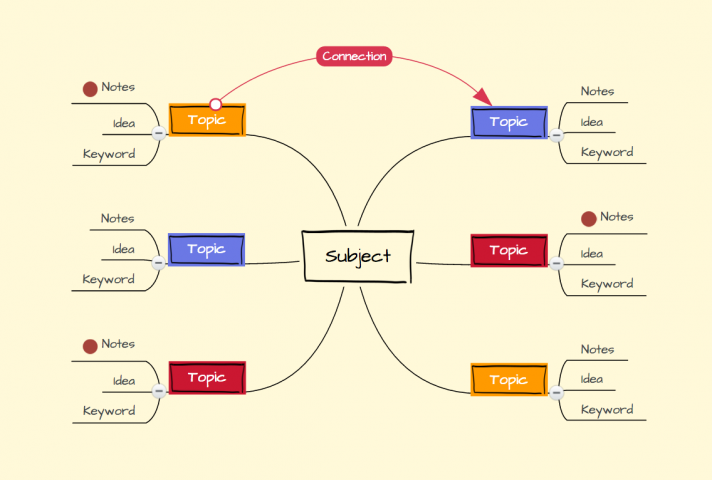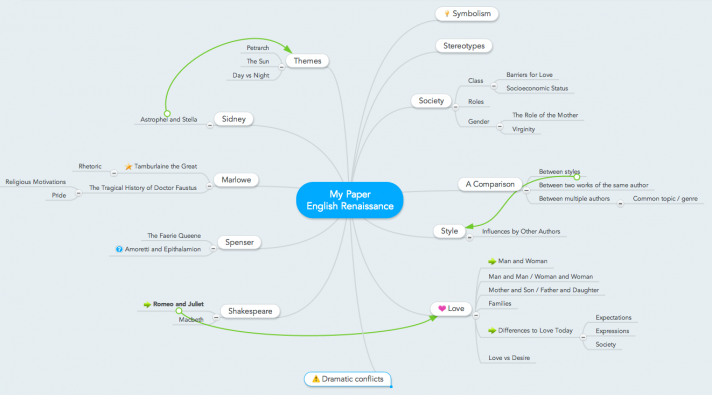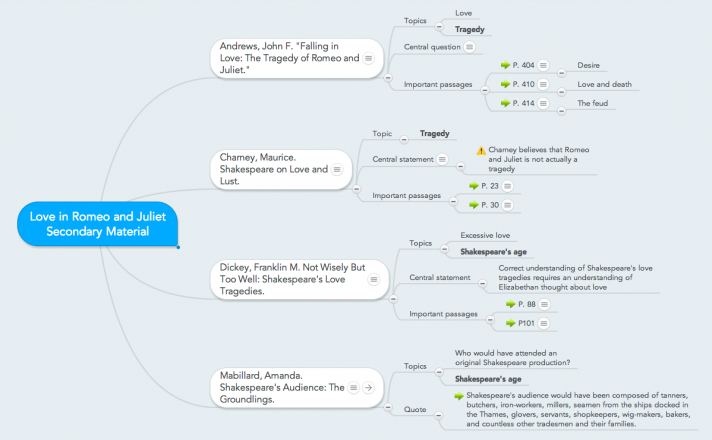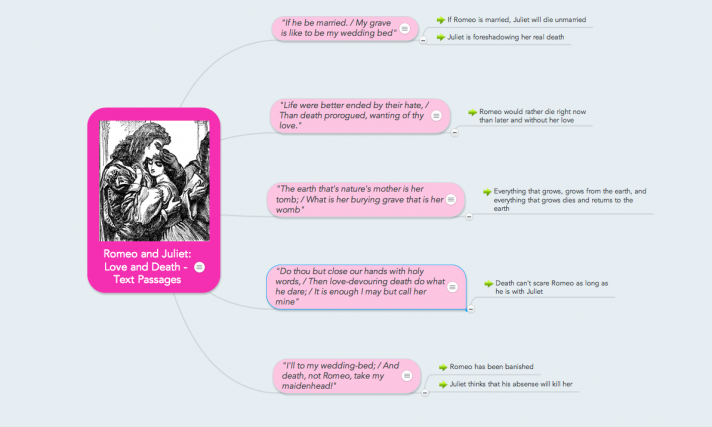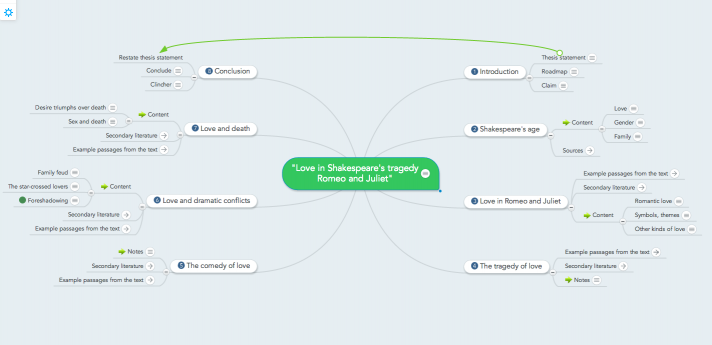In this article we’ll show you how to use mind maps for essay writing. Mind maps can not only make this often dreadful task a whole lot easier, but also save you a huge amount of time. If you want to learn how this simple yet effective technique works, just follow the steps as outlined below.

Looking for even more ways to use mind maps? Get inspired with these 13 mind map examples.
What Is a Mind Map?
A mind map is a diagram that displays information visually. You can create mind maps using pen and paper, or you can use an online mind mapping tool such as MindMeister. Whatever you use, the rules for creating a mind map are simple:
1) Write the subject in the center of your paper / canvas.
2) Draw branches that point away from the center. Each branch symbolizes one thought or idea related to the subject. Use meaningful keywords to write these ideas onto the branches.
3) From each branch more ideas can branch off. There is no limit to the number of hierarchical levels in a map.
4) Use colors, icons and images whenever possible. These function as mental triggers and can help spark new ideas in you, which is important during brainstorming sessions.
Now that you know how to create a basic mind map, let’s go over how you can use mind maps for essay writing.
Step 1: Using a Mind Map to Find a Good Topic for Your Essay
If you have the opportunity to choose the topic for your paper yourself, try to find one that’s been covered by other researchers before but still gives you a chance to come up with new findings and conclusions. If you choose a topic that has already been explored in depth by a gazillion other researchers, you might be hard-pressed to develop a unique perspective.
Ideally, the topic should be something you are also personally interested in, or at least something you can relate to in some way. This will make the whole task of writing your essay a little less dreadful. The best way to find such a topic is a brainstorming session.
How to brainstorm topic ideas in a mind map
Create a new mind map and simply write “My Essay” or “My Paper” in the center of the map. Now, start adding ideas around the center. These can be things your professor suggested, related subjects you discussed in class, or anything else relevant to get you started.
Next, note down your own areas of interest and see where they intersect with the former. Once you have a few good ideas for the subject of your paper, you can start weighing them against each other, noting down pros and cons. Eliminate topics until you’re left with only one. This will be the topic of your paper.
In the example below, the only requirement that had been given was to write a paper about literature from the English Renaissance. You’ll see various famous writers of this time mentioned in the map, as well as various aspects of their work that could be examined in a paper, such as the symbolism, dramatic conflicts or themes.
Step 2: Start the Research Process
While working through both primary and secondary sources, it’s quite easy to get confused about the numerous arguments and counterarguments mentioned by the different authors. Many students get frustrated and waste time just trying to figure out how to make all the different pieces of information fit together into a coherent text.
What you need, therefore, is a system to collect and structure all this information in one central place, so you can easily review the materials while you write.
How to collect research in a mind map
Create a new mind map for each source (book, article, essay) you read and take notes in this mind map while you work through the text. Alternatively, you can use one single map where you list all your sources and create branches for every page/paragraph/quote you want to use in your paper.
In the map below, you’ll see that — based on our initial brainstorming session — we chose ‘Love in Romeo and Juliet’ as the topic of our paper. For our research map, we wrote this topic in the center and created individual branches for each secondary source we read.
Next to the book title, we noted down the topics covered in the source, its central question as well as important passages that we thought we might want to quote in our essay.
Here are some practical tips to set you up for success:
- Use colors, arrows and icons to indicate connections between the arguments and quotes.
- Be sure to add the page numbers of your secondary sources to the topics in the map so you can quickly go back to do some more fact checking if necessary. If you’re working with online sources, you can also attach their links directly to the topics in your map.
- As you go along, you can restructure the sources according to their common themes. This usually provides a better overview of the material you have available for each section of your paper.
Here’s another example of a research map. This is the map we used to take notes while reading Shakespeare’s Romeo and Juliet, the subject of our paper. As you can see, we created branches for each of the text passages we wanted to analyze in the essay.
Step 3: Outline Your Paper in a Mind Map
Before you start with the actual writing, it’s very important that you first create an outline of your paper. This will help you create a coherent structure of your arguments, counterarguments, examples, quotes, and the sources you want to reference in each argument.
You can quickly review this outline whenever you get sidetracked in your writing process, or when you’re unsure about how to continue. A mind map is a great format for such an outline because it provides you with a visual overview of your thesis statement and the entire text structure.
If you’re using mind mapping software such as MindMeister, you can also…
- Link the individual topics in your map with the respective research maps you’ve created.
- Add notes and deadlines to each step to make sure your writing stays on schedule.
- Export your finished outline as a Word document and use it as the basis for your paper.
Using mind maps to plan and outline your essay will not only make the writing process a lot easier. It will also enable you to work through sources more efficiently and help you find and review information more quickly. Of course, you can use mind mapping for all types of writing assignments — from essays to short stories and from book reports to blog posts. Try it out!
Plan and outline your essays
Try MindMeisterSee also: The Student’s Guide to Mind Mapping

